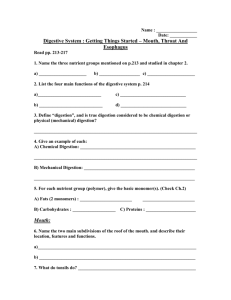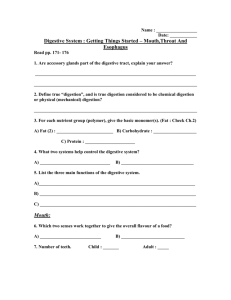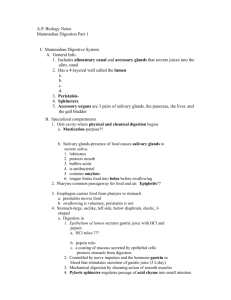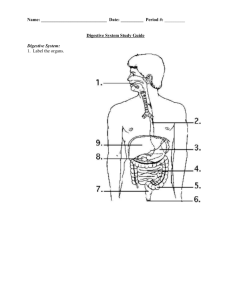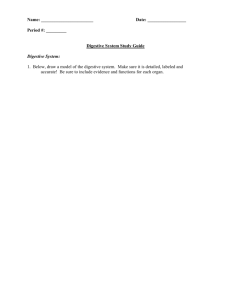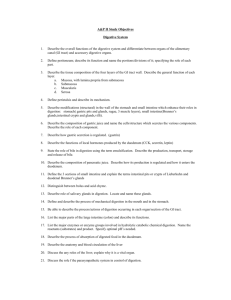Digestive System: Mouth, Throat, Esophagus - KEY
advertisement
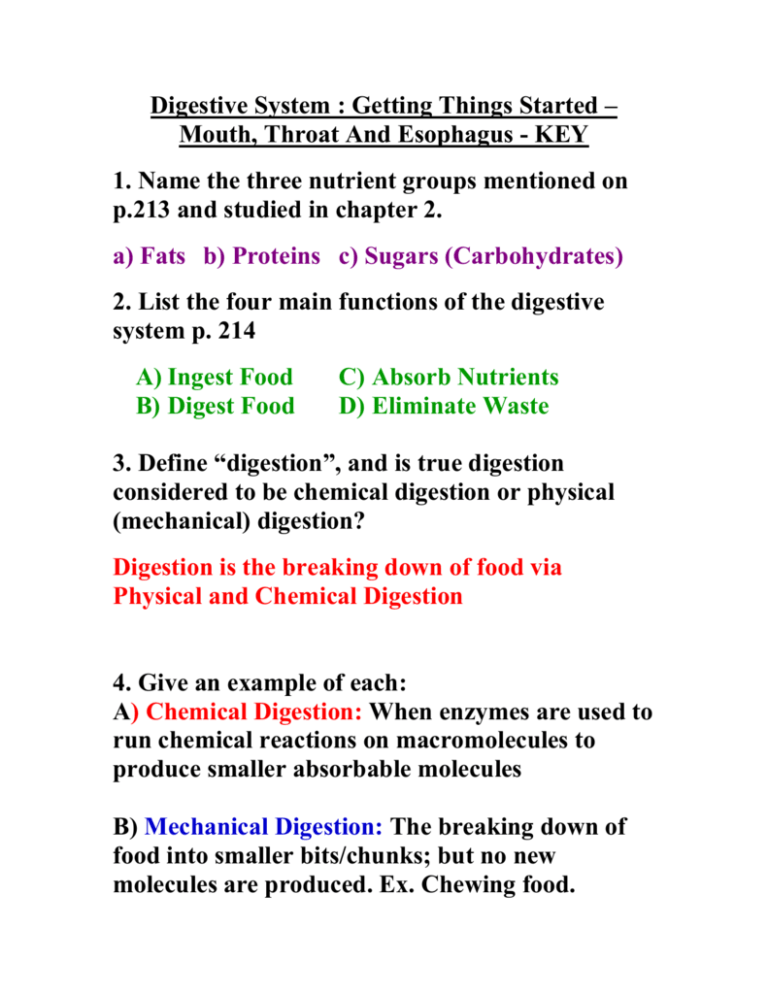
Digestive System : Getting Things Started – Mouth, Throat And Esophagus - KEY 1. Name the three nutrient groups mentioned on p.213 and studied in chapter 2. a) Fats b) Proteins c) Sugars (Carbohydrates) 2. List the four main functions of the digestive system p. 214 A) Ingest Food B) Digest Food C) Absorb Nutrients D) Eliminate Waste 3. Define “digestion”, and is true digestion considered to be chemical digestion or physical (mechanical) digestion? Digestion is the breaking down of food via Physical and Chemical Digestion 4. Give an example of each: A) Chemical Digestion: When enzymes are used to run chemical reactions on macromolecules to produce smaller absorbable molecules B) Mechanical Digestion: The breaking down of food into smaller bits/chunks; but no new molecules are produced. Ex. Chewing food. 5. For each nutrient group (polymer), give the basic monomer(s). (Check Ch.2) A) Fats (2 monomers) : Glycerol Fatty Acids B) Carbohydrates : Monosaccharides Glucose C) Proteins : Amino Acids Mouth: 6. Name the two main subdivisions of the roof of the mouth. and describe their location, features and functions. A) Toward the front of the mouth (anterior)the roof of the mouth and the nasal passages are separated by a bony plate = Hard Palate. B) Toward the back of the mouth (posterior) a the roof of the mouth is fleshy and muscular, it lifts up to close off during swallowing. = Soft Palate 7. What do tonsils do? Part of the lymphatic system and they help fight infection. 8. Number of teeth. Child : 20 Adult : 32 9. Give name, number and function for each type of tooth, per 1/2 jaw. (figure 12.2) Description Name Of Function Number/ Tooth Half Jaw ChiselIncisor Cutting 2 shaped Pointed Canine Tearing 1 Fairly Flat Pre-Molar Chew and 2 (Bicuspid) Tear Mostly Flat Molar Chew 3 10. In the diagram below label each type of tooth. A) Canine B) Molar C) Bicuspid (Premolar D) Incisor 11. How many teeth are present in the picture above? 32 12. Have the wisdom teeth in this mouth erupted? Yes 13. What are the two main parts of a tooth? A) Crown B) Root 14. Use the diagram below to label the two main parts as well as the internal structure of a tooth 15. What is gingivitis? Inflammation of the gums 16. Label the diagram below. A) Hard Palate B) Soft Palate C) Uvula Endocrine glands are ductless glands that produce hormones that are transported by the blood to affect other organs. Exocrine glands secrete their products into ducts that carry the substance into an organ or body cavity. 17. What category of gland are the salivary glands? EXOCRINE 18. Use the table below to help you label the diagram below Name of Location Salivary Gland Sublingual Sub = Below Lingual = Tongue Parotid At side of the face, immediately below and in front of the ears Submandibular Sub = Below Mandible = Lower jaw bone Use the diagram below to label the three salivary glands. PAROTID Salivary Gland SUBMANDIBULAR Salivary Gland SUBLINGUAL Salivary Gland 19. Saliva serves two purposes, name them. (One is listed, the other you should be able to figure out, especially if you try eating some soda crackers and whistling). A) Starts chemical digestion of starch B) Moistens (lubricates) food and dissolves it 20. Classify each structure as participating in either chemical digestion or physical digestion. A) Teeth: PHYSICAL (Mechanical) Digestion B) Tongue: PHYSICAL (Mechanical) Digestion C) Salivary Glands : CHEMICAL Digestion Pharynx: 21. What is the more common name for the pharynx? THROAT 22. During swallowing what two things must take place to ensure that food goes down the esophagus rather than up the nasopharynx or down the trachea? 1. Epiglottis covers over the glottis to prevent food from entering Trachea. 2. Soft palate moves back and up to cover nasopharynx. 23. What is the scientific term for the voice box? LARYNX Esophagus: 24. Use Figure 12.4 and text on p. 217 to track down the function/description for each the main parts of esophagus or most other part of the digestive tract. Name Lumen Function/Description The passageway within a tube that the bolus of food travels along Mucous Membrane Thin tissue that produces and secrete mucous.The mucous lubricates the food and protects the passageway Circular/Longitudinal Contract in rhythmic fashion to Muscle move food along the gut Serous Membrane The tissue that lines the outside of the digestive tract. It coats the outside of the structure so they don’t rub against other organs 25. Describe peristalsis? It is the rhythmic contraction of smooth muscles along the gut to move food from Throat Rectum 26. Describe "heartburn" : When acid stomach contents escape the stomach and come back up into the esophagus. This causes a burning sensation in the esophagus.
